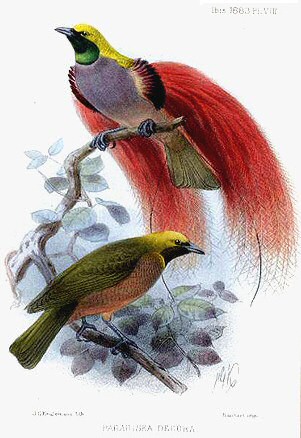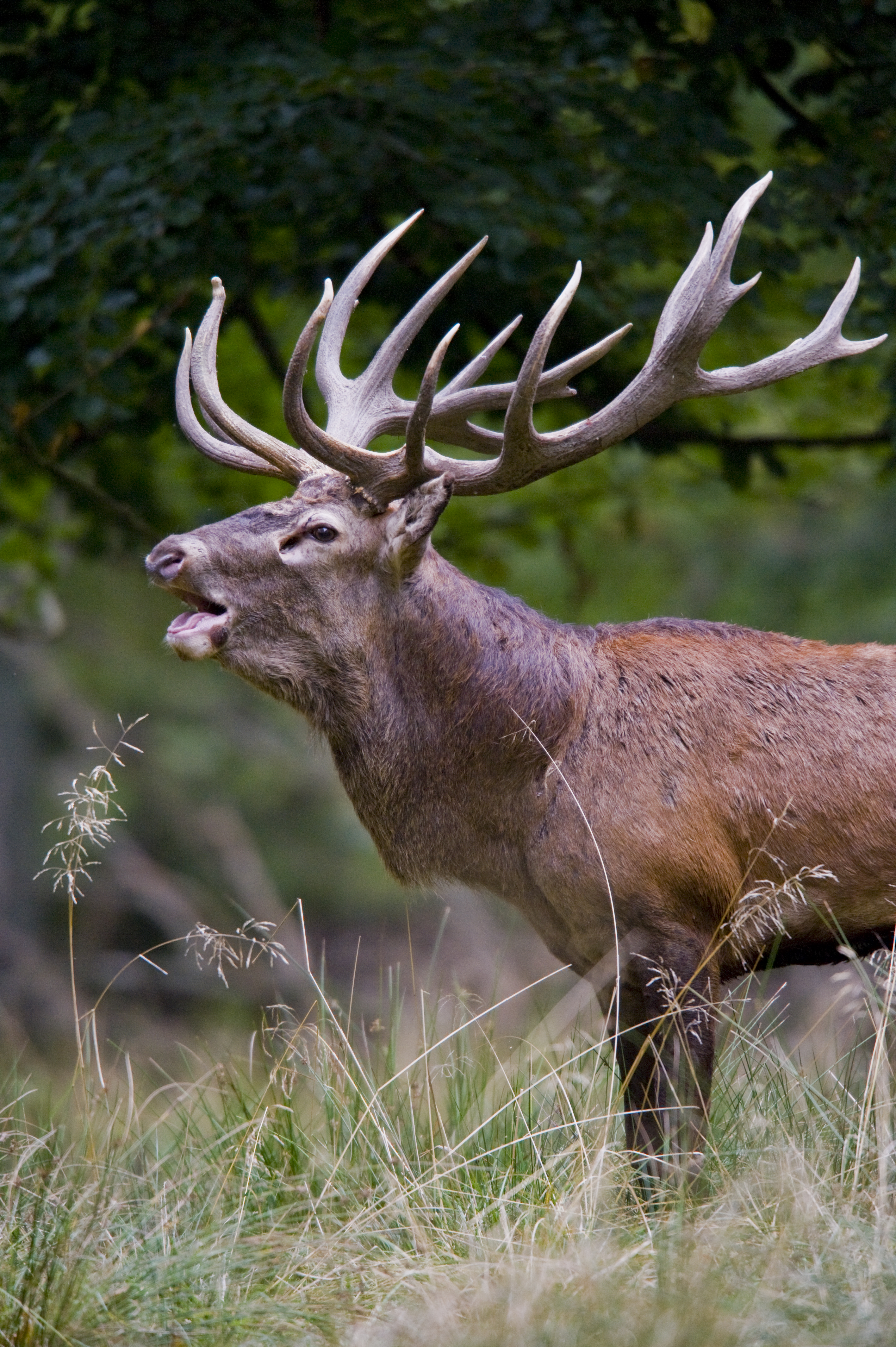|
Multiple Sexual Ornaments
Many species have multiple sexual ornaments, whereby females select mating partners using several cues instead of only one cue. Whereas this phenomenon is self-evident and hence long recognized, adaptive explanations of why females use several instead of only one signal have been formulated relatively recently. Several hypotheses exist, but mutually exclusive tests are still lacking. Hypotheses There are several hypotheses that attempt to explain why a male would have multiple sexual ornaments. Multiple messages hypothesis The multiple message hypothesis states that different ornaments signal different properties of an individual's overall quality. Models support the possibility that this hypothesis is evolutionarily stable but empirical tests are lacking. Some ornaments represent long-term or short-term changes in overall condition. Elegant plumes in a bird or antlers in a deer grown once a year could signal the overall condition of an animal during the long period of growth; ... [...More Info...] [...Related Items...] OR: [Wikipedia] [Google] [Baidu] |
Sexual Selection
Sexual selection is a mechanism of evolution in which members of one sex mate choice, choose mates of the other sex to mating, mate with (intersexual selection), and compete with members of the same sex for access to members of the opposite sex (intrasexual selection). These two forms of selection mean that some individuals have greater reproductive success than others within a population, for example because they are more Animal sexual behaviour, attractive or prefer more attractive partners to produce offspring. Successful males benefit from frequent mating and monopolizing access to one or more fertile females. Females can maximise the return on the energy they invest in reproduction by selecting and mating with the best males. The concept was first articulated by Charles Darwin who wrote of a "second agency" other than natural selection, in which competition between mate candidates could lead to speciation. The theory was given a mathematical basis by Ronald Fisher in the e ... [...More Info...] [...Related Items...] OR: [Wikipedia] [Google] [Baidu] |
Signalling Theory
Within evolutionary biology, signalling theory is a body of theoretical work examining communication between individuals, both within species and across species. The central question is how organisms with conflicting interests, such as in sexual selection, are expected to provide honest signals rather than deceive or cheat, given that the passing on of pleiotropic traits is subject to natural selection, which aims to minimize associated costs without assuming any conscious intent. Mathematical models describe how signalling can contribute to an evolutionarily stable strategy. Signals are given in contexts such as mate selection by females, which subjects the advertising males' signals to selective pressure. Signals thus evolve because they modify the behaviour of the receiver to benefit the signaller. Signals may be honest, conveying information which usefully increases the fitness of the receiver, or dishonest. An individual can cheat by giving a dishonest signal, which m ... [...More Info...] [...Related Items...] OR: [Wikipedia] [Google] [Baidu] |
Signaling Theory
Within evolutionary biology, signalling theory is a body of theory, theoretical work examining animal communication, communication between individuals, both within species and across species. The central question is how organisms with conflicting interests, such as in sexual selection, are expected to provide honest signals rather than deceive or Cheating (biology), cheat, given that the passing on of Pleiotropy, pleiotropic traits is subject to natural selection, which aims to minimize associated costs without assuming any conscious intent. Mathematical models describe how signalling can contribute to an evolutionarily stable strategy. Signals are given in contexts such as mate selection by females, which subjects the advertising in biology, advertising males' signals to selective pressure. Signals thus evolve because they modify the behaviour of the receiver to benefit the signaller. Signals may be honest, conveying information which usefully increases the fitness of the rece ... [...More Info...] [...Related Items...] OR: [Wikipedia] [Google] [Baidu] |
Antlers
Antlers are extensions of an animal's skull found in members of the Cervidae (deer) Family (biology), family. Antlers are a single structure composed of bone, cartilage, fibrous tissue, skin, nerves, and blood vessels. They are generally found only on males, with the exception of Reindeer, reindeer/caribou. Antlers are Moulting, shed and regrown each year and function primarily as objects of sexual attraction and as Weapon (biology), weapons. Etymology Antler comes from the Old French ''antoillier ''(see present French : "Andouiller", from'' ant-, ''meaning before,'' oeil, ''meaning eye and'' -ier'', a suffix indicating an action or state of being) possibly from some form of an unattested Latin word ''*anteocularis'', "before the eye" (and applied to the word for "branch" or "horn (anatomy), horn"). Structure and development Antlers are unique to cervids. The ancestors of deer had tusks (long upper canine tooth, canine teeth). In most species, antlers appear to replace t ... [...More Info...] [...Related Items...] OR: [Wikipedia] [Google] [Baidu] |
Grouse
Grouse are a group of birds from the order (biology), order Galliformes, in the family (biology), family Phasianidae. Grouse are presently assigned to the Tribe (biology), tribe Tetraonini (formerly the subfamily Tetraoninae and the family Tetraonidae), a classification supported by mitochondrial DNA sequence studies, and applied by the American Ornithologists' Union, ITIS, International Ornithologists' Union, International Ornithological Congress, and others. Grouse inhabit temperate and subarctic regions of the Northern Hemisphere, from pine trees, pine forests to moorland and mountainside, from 83rd parallel north, 83°N (rock ptarmigan in northern Greenland) to 28th parallel north, 28°N (Attwater's prairie chicken in Texas). The Turkey (bird), turkeys are closely allied with grouse, but they have traditionally been excluded from Tetraonini, often placed in their own tribe, subfamily, or family; certain more modern treatments also exclude them. Later phylogenomic analyses ... [...More Info...] [...Related Items...] OR: [Wikipedia] [Google] [Baidu] |
Primate
Primates is an order (biology), order of mammals, which is further divided into the Strepsirrhini, strepsirrhines, which include lemurs, galagos, and Lorisidae, lorisids; and the Haplorhini, haplorhines, which include Tarsiiformes, tarsiers and simians (monkeys and apes). Primates arose 74–63 million years ago first from small terrestrial animal, terrestrial mammals, which adapted for life in tropical forests: many primate characteristics represent adaptations to the challenging environment among Canopy (biology), tree tops, including large brain sizes, binocular vision, color vision, Animal communication, vocalizations, shoulder girdles allowing a large degree of movement in the upper limbs, and opposable thumbs (in most but not all) that enable better grasping and dexterity. Primates range in size from Madame Berthe's mouse lemur, which weighs , to the eastern gorilla, weighing over . There are 376–524 species of living primates, depending on which classification is ... [...More Info...] [...Related Items...] OR: [Wikipedia] [Google] [Baidu] |
Mate Choice
Mate choice is one of the primary mechanisms under which evolution can occur. It is characterized by a "selective response by animals to particular stimuli" which can be observed as behavior.Bateson, Paul Patrick Gordon. "Mate Choice." Mate Choice, Cambridge University Press, 1985 In other words, before an animal engages with a potential mate, they first evaluate various aspects of that mate which are indicative of quality—such as the resources or phenotypes they have—and evaluate whether or not those particular Phenotypic trait, trait(s) are somehow beneficial to them. The evaluation will then incur a response of some sort. These mechanisms are a part of evolutionary change because they operate in a way that causes the qualities that are desired in a mate to be more frequently passed on to each generation over time. For example, if female peacocks desire mates who have a colourful plumage, then this trait will increase in frequency over time as male peacocks with a colourful ... [...More Info...] [...Related Items...] OR: [Wikipedia] [Google] [Baidu] |
Animal Sexuality
Animal sexual behaviour takes many different forms, including within the same species. Common mating or reproductively motivated systems include monogamy, polygyny, polyandry, polygamy and promiscuity. Other sexual behaviour may be reproductively motivated (e.g. sex apparently due to duress or coercion and situational sexual behaviour) or non-reproductively motivated (e.g. homosexual sexual behaviour, bisexual sexual behaviour, cross-species sex, sexual arousal from objects or places, sex with dead animals, etc.). When animal sexual behaviour is reproductively motivated, it is often termed ''mating'' or '' copulation''; for most non-human mammals, mating and copulation occur at oestrus (the most fertile period in the mammalian female's reproductive cycle), which increases the chances of successful impregnation. Some animal sexual behaviour involves competition, sometimes fighting, between multiple males. Females often select males for mating only if they appear strong ... [...More Info...] [...Related Items...] OR: [Wikipedia] [Google] [Baidu] |





